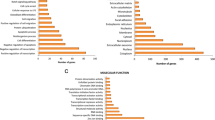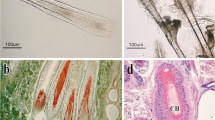Abstract
Ladakh, one of the highest inhabited regions globally, hosts the unique Changthangi goat, renowned for producing Pashmina, the world’s most luxurious natural fiber. In comparison, the fiber derived from Changthangi sheep is considered next only to Pashmina. This research endeavors to compare the skin transcriptome profiles of Changthangi goats and Changthangi sheep, aiming to discern the molecular determinants behind the recognition of Changthangi goats as the source of Pashmina. Drawing upon previously conducted studies, a collective of 225 genes correlated with fiber characteristics were extracted from the differentially expressed genes noticed between the two species (p-value of ≤ 0.05 and a log2 fold change of ≥ 1.5). These genes were analyzed using DAVID software to understand their biological functions and to identify enriched KEGG and Reactome pathways. The protein-protein interaction networks were constructed using Cytoscape, cytoHubba, and STRING to focus on key genes and infer their biological significance. Comparative transcriptome analysis revealed significantly higher expression of genes involved in signaling pathways like Wnt, MAPK, PI3K-Akt, Hedgehog, associated with fiber development and quality in Changthangi goats. These pathways play crucial roles in hair follicle (HF) formation, maintenance of epidermal stem cells, and fiber characteristics. Findings also highlight the enrichment of cell adhesion molecules and ECM-receptor interaction, emphasizing their roles in HF structure, growth, and signaling. This investigation offers an in-depth understanding of the molecular intricacies governing Pashmina production in Changthangi goats, providing valuable insights into their unique genetic makeup and underlying mechanisms influencing the exceptional quality of Pashmina fibers.




Similar content being viewed by others
Data availability
The data associated with this manuscript has been submitted in NCBI and accession numbers are mentioned in the manuscript.
References
Abe Y, Tanaka N (2017) Roles of the hedgehog signaling pathway in epidermal and hair follicle development, homeostasis, and cancer. J Dev Biology 5(4):12
Ahlawat S, Arora R, Sharma R, Sharma U, Kaur M, Kumar A, Vijh RK (2020) Skin transcriptome profiling of Changthangi goats highlights the relevance of genes involved in pashmina production. Sci Rep 10(1):6050
Ahlawat S, Vasu V, Choudhary V, Arora R, Sharma R, Mir MA, Singh MK (2024) Comprehensive evaluation and validation of optimal reference genes for normalization of qPCR data in different caprine tissues. Mol Biol Rep 51:268
Andl T, Reddy ST, Gaddapara T, Millar SE (2002) WNT signals are required for the initiation of hair follicle development. Dev Cell 2:643–653
Andrews S (2010) FastQC: A quality control tool for high throughput sequence data. http://www.bioinformatics.babraham.ac.uk/projects/fastqc
Arora R, Siddaraju NK, Manjunatha SS, Sudarshan S, Fairoze MN, Kumar A, Chhabra P, Kaur M, Sreesujatha RM, Ahlawat S, Vijh RK (2021) Muscle transcriptome provides the first insight into the dynamics of gene expression with progression of age in sheep. Sci Rep 11(1):22360
Beigh AB, Bashir S (2019) Pashmina goat farming in cold arid desert of Changthang and its impact on economy. https://doi.org/10.5772/intechopen.84523
Bhat B, Singh A, Iqbal Z, Kaushik JK, Rao AR, Ahmad SM, Ganai NA (2019) Comparative transcriptome analysis reveals the genetic basis of coat color variation in Pashmina goat. Sci Rep 9(1):6361
Bhat B, Yaseen M, Singh A, Ahmad SM, Ganai NA (2021) Identification of potential key genes and pathways associated with the Pashmina fiber initiation using RNA-Seq and integrated bioinformatics analysis. Sci Rep 11(1):1766
Bhattacharya T, Siddhartha M, Sheikh F, Sharma A (2004) Changthangi goats: a rich source of pashmina production in Ladakh. Anim Genetic Resources/ Resour Génétiquesanimales/ Recursosgenéticos Anim 35:75–85
Chin CH, Chen SH, Wu HH, Ho CW, Ko MT, Lin CY (2014) cytoHubba: identifying hub objects and sub-networks from complex interactome. BMC Syst Biol 8(4):S11
Ding H, Zhao H, Cheng G, Yang Y, Wang X, Zhao X, Huang D (2019) Analyses of histological and transcriptome differences in the skin of short-hair and long-hair rabbits. BMC Genomics 20(1):1–12
Gao Y, Wang X, Yan H, Zeng J, Ma S, Niu Y, Chen Y (2016) Comparative transcriptome analysis of fetal skin reveals key genes related to hair follicle morphogenesis in Cashmere goats. PLoS ONE 11(3):e0151118
Gao WZ, Xue HL, Yang JC (2021) Proteomics analysis of the secondary hair follicle cycle in Liaoning cashmere goat. Small Ruminant Res 201:106408
Huang DW, Sherman BT, Lempicki RA (2009) Systematic and integrative analysis of large gene lists using DAVID Bioinformatics resources. Nat Protoc 4:44–57
Kandyba E, Kobielak K (2014) Wnt7b is an important intrinsic regulator of hair follicle stem cell homeostasis and hair follicle cycling. Stem Cells 32(4):886–901
Kaur M, Kumar A, Siddaraju NK, Fairoze MN, Chhabra P, Ahlawat S, Vijh RK, Yadav A, Arora R (2020) Differential expression of miRNAs in skeletal muscles of Indian sheep with diverse carcass and muscle traits. Sci Rep 10(1):16332
Langbein L, Schweizer J (2005) Keratins of the human hair follicle. Int Rev Cytol 243:1–79
Liu G, Liu R, Tang X, Cao J, Zhao S, Yu M (2015) Expression profiling reveals genes involved in the regulation of wool follicle bulb regression and regeneration in sheep. Int J Mol Sci 16(5):9152–9166
Livak KJ, Schmittgen TD (2001) Analysis of relative gene expression data using real time quantitative PCR and the 2(-Delta DeltaC(T)) method. Methods 25:402–408
Ma S, Long L, Huang X, Tian K, Tian Y, Wu C, Zhao Z (2023) Transcriptome analysis reveals genes associated with wool fineness in merinos. Peer J 11:e15327
Malik AA, Khan HM, Sofi AH, Mir MS, Farooq J, Sheikh FD, Abdullah M (2021) Wool characteristics of Changthangi sheep. Small Ruminant Res 199:106364
Qiao L, Gu Y, Guo S, Li S, Wang J, Hao Z, Luo Y, Liu X, Li S, Zhao F, Li M (2023) The identification and characteristics of miRNAs related to Cashmere fiber traits in skin tissue of Cashmere goats. Genes (Basel) 14(2):473
Rishikaysh P, Dev K, Diaz D, Qureshi WM, Filip S, Mokry J (2014) Signaling involved in hair follicle morphogenesis and development. Int J Mol Sci 15(1):1647–1670
Shakyawar D, Raja A, Ajay K, Pareek P, Wani S (2013) Pashmina fibre: production, characteristics and utilization. Indian J Fibre Text Res 38:207–214
Shannon P, Markiel A, Ozier O, Baliga NS, Wang JT, Ramage D, Amin N, Schwikowski B, Ideker T (2003) Cytoscape: A software environment for integrated models of biomolecular interaction networks. Genome Res 13:2498–2504
Sheikh FD (2022) Status of world’s unique animal genetic resource of Ladakh. https://doi.org/10.5772/intechopen.103767
Shi R, Li S, Liu P, Zhang S, Wu Z, Wu T, Gong S, Wan Y (2022) Identification of key genes and signaling pathways related to Hetian sheep wool density by RNA-seq technology. PLoS ONE 17(5):e0265989
Suarez AGF, Reynoso GAG, Bravo FDL (2019) Bioinformatic identification of single nucleotide polymorphisms (SNPs) in candidate genes for fiber characteristics in alpacas (Vicugna pacos). Revista Peruana De Biol 26(1):87–94
Szklarczyk D, Morris JH, Cook H, Kuhn M, Wyder S, Simonovic M, Santos A, Doncheva NT, Roth A, Bork P, Jensen LJ, von Mering C (2017) The STRING database in 2017: Quality controlled protein-protein association networks, made broadly accessible. Nucleic Acids Res 45(D1):D362–D368
Untergasser A, Cutcutache I, Koressaar T, Ye J, Faircloth BC, Remm M, Rozen SG (2012) Primer3—new capabilities and interfaces. Nucleic Acids Res 40(15):e115–e115
Vasu V, Ahlawat S, Chhabra P, Sharma U, Arora R, Sharma R, Mir MA, Singh MK (2023a) Genetic insights into fiber quality, coat color and adaptation in Changthangi and Muzzafarnagri sheep: a comparative skin transcriptome analysis. Gene 891:147826
Vasu V, Ahlawat S, Choudhary V, Kaur R, Arora R, Sharma R, Sharma U, Chhabra P, Mir MA, Singh MK (2023b) Identification and validation of stable reference genes for expression profiling of target genes in diverse ovine tissues. Gene 897:148067
Wang Z, Wang Y, Hui T, Chen R, Xu Y, Zhang Y, Zheng Y (2021a) Single-cell sequencing reveals differential cell types in skin tissues of liaoning cashmere goats and key genes related potentially to the fineness of Cashmere fiber. Front Genet 12:726670
Wang FH, Zhang L, Gong G, Yan XC, Zhang LT, Zhang FT, Li JQ (2021b) Genome wide association study of fleece traits in Inner Mongolia Cashmere goats. Anim Genet 52(3):375–379
Wu C, Li J, Xu X, Xu Q, Qin C, Liu G, Fu X (2022) Effect of the FA2H gene on cashmere fineness of Jiangnan cashmere goats based on transcriptome sequencing. BMC Genomics 23(1):1–14
Yang M, Song S, Dong K, Chen X, Liu X, Rouzi M, Jiang L (2017) Skin transcriptome reveals the intrinsic molecular mechanisms underlying hair follicle cycling in Cashmere goats under natural and shortened photoperiod conditions. Sci Rep 7(1):13502
Yu Z, Wildermoth JE, Wallace OA, Gordon SW, Maqbool NJ, Maclean PH, Pearson AJ (2011) Annotation of sheep keratin intermediate filament genes and their patterns of expression. Exp Dermatol 20(7):582–588
Zhang Y, Wang L, Li Z, Chen D, Han W, Wu Z, Shang F, Hai E, Wei Y, Su R, Liu Z, Wang R, Wang Z, Zhao Y, Wang Z, Zhang Y, Li J (2019) Transcriptome profiling reveals transcriptional and alternative splicing regulation in the early embryonic development of hair follicles in the cashmere goat. Sci Rep 9(1):17735
Zhang CZ, Sun HZ, Zhang CH, Jin L, Sang D, Li SL (2020) Effects of photoperiod on circadian clock genes in skin contribute to the regulation of hair follicle cycling of Inner Mongolia white cashmere goats. Anim Sci J 91(1):e13320
Zhao B, Wu C, Sammad A, Ma Z, Suo L, Wu Y, Fu X (2022) The fiber diameter traits of tibetan cashmere goats are governed by the inherent differences in stress, hypoxic, and metabolic adaptations: an integrative study of proteome and transcriptome. BMC Genomics 23:191
Zhu B, Xu T, Yuan J, Guo X, Liu D (2013) Transcriptome sequencing reveals differences between primary and secondary hair follicle-derived dermal papilla cells of the Cashmere goat (Capra hircus). PLoS ONE 8(9):e76282
Funding
This work was financially supported by the ICAR-Consortium Research Platform- Genomics.
Author information
Authors and Affiliations
Contributions
S.A. and R.A. conceived and designed research. M.V. conducted experiments. M.A.M. and M.K.S. contributed resources. P.C. and U.S. analyzed data. S.A. and R.S. wrote the manuscript. All authors approved the manuscript.
Corresponding author
Ethics declarations
Competing interests
The authors declare no competing interests.
Additional information
Publisher’s Note
Springer Nature remains neutral with regard to jurisdictional claims in published maps and institutional affiliations.
Electronic supplementary material
Below is the link to the electronic supplementary material.
Rights and permissions
Springer Nature or its licensor (e.g. a society or other partner) holds exclusive rights to this article under a publishing agreement with the author(s) or other rightsholder(s); author self-archiving of the accepted manuscript version of this article is solely governed by the terms of such publishing agreement and applicable law.
About this article
Cite this article
Ahlawat, S., Vasu, M., Mir, M. et al. Molecular insights into Pashmina fiber production: comparative skin transcriptomic analysis of Changthangi goats and sheep. Mamm Genome (2024). https://doi.org/10.1007/s00335-024-10040-9
Received:
Accepted:
Published:
DOI: https://doi.org/10.1007/s00335-024-10040-9




